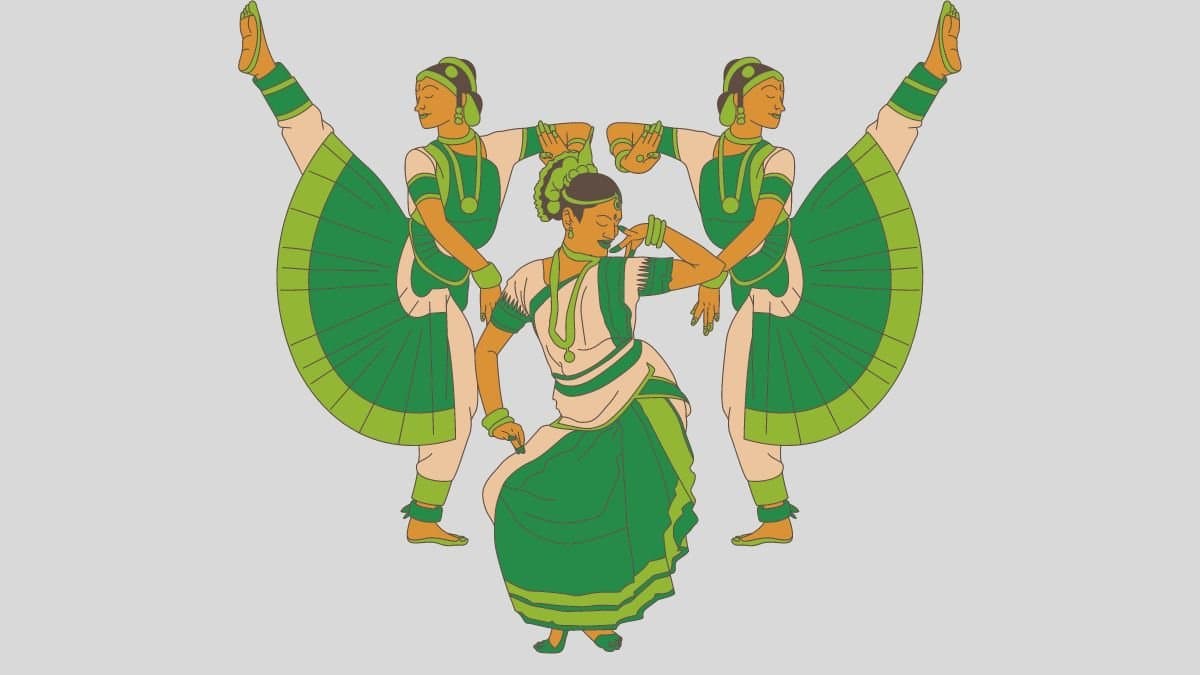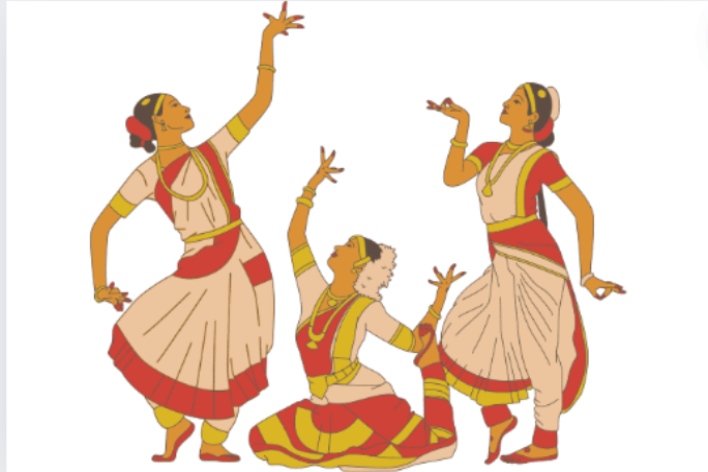Bharatanatyam: The Classical Dance of Tamil Nadu
By Pinkey Sharma |
Date 16-08-2024

Table of Contents
Admissions Open for
Have any of you ever watched any dance form where there is storytelling through graceful movements and expressive gestures? One of the most vibrant dances of India is the Bharatanatyam Dance. Come along into the enchanting world of Bharatanatyam to learn about its history, costumes, and performances.
What is Bharatanatyam Dance?
Bharatanatyam is a form of classical dance from Tamil Nadu, one of the southern states of India. It has been an ancient Indian art form practiced even today, dating back thousands of years. Picture a dance where grace and movement combine with storytelling and intricate footwork; that would be Bharatanatyam.
While watching Bharatanatyam, one can notice that dancers use their whole bodies to express various emotions and tales. It is not some dance; instead, it is an attempt to show a story with expressions and body language.
Bharatanatyam Dance: Which State is it from?
Bharatanatyam dance originated in Tamil Nadu. This southern state of India is known for its rich culture and traditions. The first performances of this style were performed in temples by devadasis, women dedicated to serving the temple gods through dance and music.
History of Bharatanatyam
The history of Bharatanatyam is very ancient. It goes back to about more than 2,000 years to ancient texts known as the Natya Shastra, written by Bharata Muni. These describe the principles of Indian classical dance and are regarded as the basis of Bharatanatyam dance.
Originally, Bharatanatyam dance was performed as an offering to God in temples. The dance served as a means of expression of reverence by devadasis towards the gods and goddesses. Later, Bharatanatyam moved from the temple to the stage, and today, it is performed all over the world.
Bharatanatyam Costume
As soon as a viewer enters the hall for a Bharatanatyam performance, he is struck by the costume. Bharatanatyam dance costumes are colorful and very elaborate to bring out every movement or expression of the dancer.
The Bharatanatyam costume consists of a sari—a long piece of cloth—that is draped neatly around the dancer. It usually comes in silk, with gold or silver thread embroidery; this is worn with the matching blouse and the decorative belt.
It also comprises exquisite jewelry that includes necklaces, earrings, and headpieces. Jewelry helps in tracing the movement flow of the dancer and adds visual beauty to the performance.
Bharatanatyam Arangetram
Probably a very important event in a Bharatanatyam dancer's life is called the Arangetram. It is that special performance that marks the dancer's debut as a professional artist. That is a great milestone and is meant to express that the dancer has fully mastered the dance form.
In the Arangetram, a suite of traditional pieces is presented by a dancer to prove proficiency in Bharatanatyam. It is, in fact, years of hard work and dedication towards the dance form celebrated.
Bharatanatyam Mudras
Mudras are hand gestures applied to express or indicate various ideas and feelings of Bharatanatyam. It is a way of expressing emotions towards the divine. For each mudra, definite titles are given. They have an entirely different significance and they become part and parcel of the dance.

Pataka
The literal meaning is "Flag." The most basic one, and the first one taught to absolute beginners, is pataka. The thumb is slightly bent, but the fingers are straight and the hand is upright with a slight arch. The fingers are not separated in any manner. It is also a very simple gesture: it means to stop as well as to bless the sky, air, or water.
Tripataka
This mudra also has the hand held erect as in the Pataka Mudra, but the third finger is bent. The name Tripataka mudra conveys the idea that this is a mudra with three fingers in place of the Pataka mudra. It not only represents a king or the crown but also the action of applying tilak.
Mayura
The literal meaning of the word "Mayura" is " peacock". The peacock is inferred when the ring finger and the thumb come together. The remaining little, middle and the index fingers are extended. The pose depicts a peacock, the neck of a bird, feathers of Krishna and even creepers. This mudra is generally with quick-footed movements.
Alapadma
The lotus mudra represents a blooming lotus. With the help of the different fingers and thumb, stretch and curl the fingers in the respective directions so that they form the petals of a lotus flower. Constructive powers existing in both spiritual and material domains are represented by the mudra. It stands for wisdom, romance, and creation.
Ardhapataka
Branch or leaf is depicted by the position of the half-flag hand. It’s an element of nature that can also create plants or trees.
Chandrakala
This mudra symbolizes moon-like forms, represented here by its round shape made with fingers forming a crescent. It expresses beauty, tenderness and gentleness.
Anjali
It’s a symbol of respect or greeting by placing palms together before the chest area; where it appears more like praying with one’s arms crossed before one’s heart in honor or love towards someone. It is generally used to commence or conclude theatrical acts.
In addition to the above, there are various other mudras like Kartarimukha, Ardhachandra, Arala, Shukatunda, Mushthi, Shikhara, Sarpashirsha etc. The hand movements may be referred to by different names in different dance schools and styles. The primary goal of doing a mudra is to communicate. Like all other traditional Indian arts, bharatanatyam has flourished across the world.
How Bharatanatyam Dance is Performed?
The Bharatanatyam is danced to the rhythm of traditional music that is played by a live orchestra. The dance contains a few sections, all different in its intention and style:
Alarippu
It is the preliminary dance where the dancer presents rhythmic exercises to the audience to make them ready for the performance.
Jatiswaram
Pure dance is the prime factor in this part, with complex patterns and footwork that the performer performs to demonstrate his technical skill in the dance form.
Varnam
Varnam is the most important and longest section of the performance. In this section, dance, music, and narration are combined, with the performer being given enough time to express emotion and tell the story.
Padams
In this piece, the dancer performs abhinaya sections that either reflect or evoke different emotions and moods. This is one moment where a dancer can show their artistry by really letting go and getting into the mood with which they can identify, hence feeling a good connection with the audience.
Tillana
The final piece always performed is the Tillana—a quick, vibrant piece. It consists of a fast phase and brisk movements in simple geometrical patterns and is marked by brisk movements and cheerful rhythms.
Shloka
Finally, a Shloka, which is a devotional piece inserted to thank the gods for their good graces in having reached the end of one's performance, is done.
Why is Bharatanatyam Dance Important?
Bharatanatyam dance is much more than entertainment; it is a pathway to reaching one's roots in Indian culture and its traditions. It is a medium that ascertains ancient stories and customs and allows the appreciation of beauty through classical dance.
To most dancers, Bharatanatyam becomes an instrument to give vent to one's feelings and to share the joy of the art form with others. It unites them and generates a sense of community, and pride.
Fun Facts About Bharatanatyam
Ancient Dance Form
Among the Indian classical dances, Bharatanatyam happens to be abundant in antiquity.
Meaningful Gestures
The Mudras that are used in Bharatanatyam tend to have a few meanings to convey and make up part of the narrative gestures in the dance form.
Colorful attires
Bharatanatyam dance costumes are extremely colorful with intricate design works on them.
World Appeal
Bharatanatyam dancers are spread throughout the world from the United States to India, and many other countries.
Bharatanatyam for Kids
Bharatanatyam is an Indian classical dance that narrates stories through graceful movements and expressive gestures. The dance is good for children to learn about culture, enhance their balance, and have fun doing it. It is actually an educationally enjoyable combination of rhythm, music, and acting. The kids could develop confidence, creativity, and discipline while engaging themselves in this beautiful art.
Conclusion
Bharatanatyam dance is an art form from Tamil Nadu in India; more precisely, it is a very magnificent and enthralling dance. It is a dance of emotional expression, hence a means for associating others with the rich traditions of Indian culture. With its ravishing costumes, expressive body movements, and captivating music, Bharatanatyam goes on to inspire and delight audiences worldwide.
Is it not amazing how dance brings stories to life and connects us across different cultures? Whether you're dancing or just watching, Bharatanatyam is a beautiful way to experience the joy of movement and the power of storytelling.
Liked the above article? Kindly share it with your Bharatanatyam loving friends. Live in the high-spirited world of Bharatanatyam folk dance and celebrate its heritage in every rhythmic step!
CBSE Schools In Popular Cities
- CBSE Schools in Bangalore
- CBSE Schools in Mumbai
- CBSE Schools in Pune
- CBSE Schools in Hyderabad
- CBSE Schools in Chennai
- CBSE Schools in Gurgaon
- CBSE Schools in Kolkata
- CBSE Schools in Indore
- CBSE Schools in Sonipat
- CBSE Schools in Delhi
- CBSE Schools in Rohtak
- CBSE Schools in Bhopal
- CBSE Schools in Aurangabad
- CBSE Schools in Jabalpur
- CBSE Schools in Jaipur
- CBSE Schools in Jodhpur
- CBSE Schools in Nagpur
- CBSE Schools in Ahmednagar
- CBSE School In Tumkur

Call Us to know more about Orchids
Swipe Up



.jpg&w=1920&q=80)












